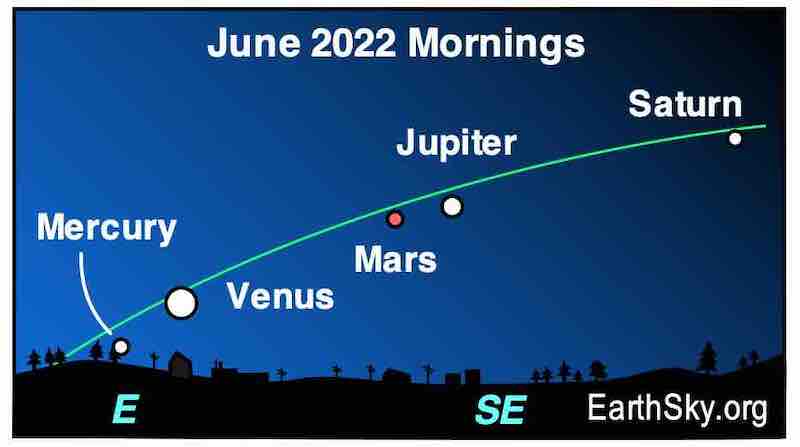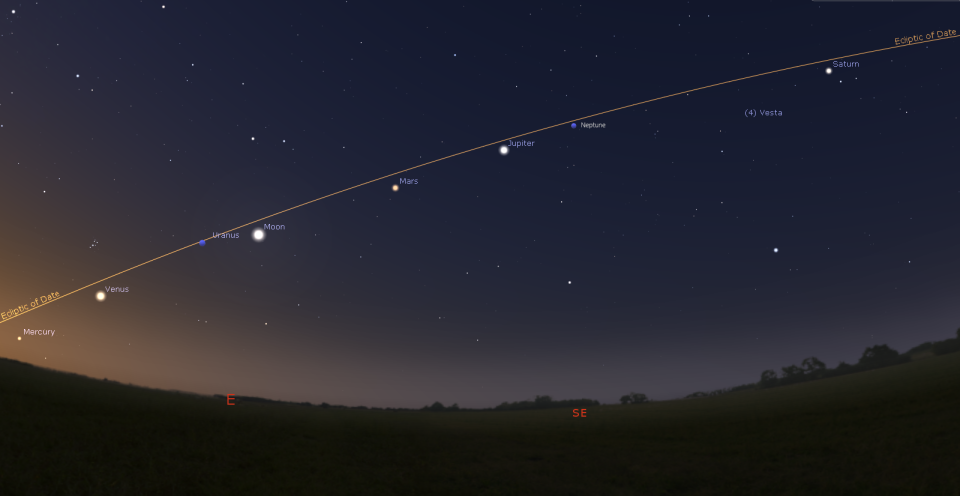Sky Shorts: June to feature seven-planet viewing extravaganza

We are in for a rare sight in our morning sky in June.
We will not only see the five planets visible to the human eye – Mercury, Venus, Mars, Jupiter and Saturn – but also Uranus and Neptune.
Uranus and Neptune can be viewed with binoculars or with a small telescope. Best dates for viewing will be June 16-27. The Moon joins this phenomenal sight from June 18-27.
We also will enjoy a visit from asteroid Vesta. The real thrill will be that the five visible planets will be stretched across the ecliptic in the correct order from their distance from the Sun. The planets will be spread along a 106-degree line of the ecliptic.
The ecliptic is the imaginary line in the sky that marks the path of the Sun. It traces out the apparent annual motion of the Sun across the sky. The planets orbit in approximately the same plane as Earth, so they appear along the ecliptic. So, we will be able to see how the visible planets are lying along the ecliptic in our June predawn sky.
As we head into June, Venus, Mars, Jupiter and Saturn continue to put on a spectacular show in the predawn sky. Mercury will be too faint to see in early June, but brightens to magnitude 1.0 on June 11, to 0.5 on June 16, 0.0 on June 21 and -0.7 by month’s end. Mercury reaches greatest western elongation or distance from the Sun on the sky’s dome on June 16 and rises a little before 5 a.m. That will give us 30 minutes of viewing before morning twilight interferes. The Sun rises just before 6 a.m. Mercury can be found about 10 degrees to the lower left of Venus. You might need binoculars.

The best morning to take in this rarity is June 24, 50 minutes before sunrise, which is 5:54 a.m. The Moon will be positioned between Venus and Mars. So, the visible object lineup will be Mercury, Venus, the Moon, Mars, Jupiter and Saturn. The magnitude of each planet is: Mercury -0.1, Venus -3.9, Mars,0.5, Jupiter -2.4, and Saturn 0.5.
Magnitude is the measure of apparent brightness of a celestial object. The lower the value, the brighter the object, hence Venus is the brightest. Set your alarm and enjoy this rare sight!
Space exploration
The world’s largest and most powerful space telescope, the James Webb Space Telescope, has entered the homestretch of its commissioning. Engineers are in the final tweaking stage to the instruments. We may see the first images by late June!
Night Sky for June
Planets and the Moon:
There will be no visible planets again this month in the evening sky. Saturn rises after 1 a.m. and shortly after midnight by mid-June. Saturn reaches a stationary point on June 5 and begins retrograde motion. Jupiter and Mars rise together in the eastern sky on June 1, soon after 2:30 a.m. The pair stand less than two degrees apart, and Jupiter will be brighter. Jupiter and Mars will begin to drift apart each day in June. Jupiter rises before 1 a.m. at the end of June. Neptune rises after 2 a.m. in early June and after midnight in late June. Early June will be the best time to locate Neptune. Locate Jupiter and look westward to find 4th magnitude star, Phi Aquarii. Neptune will be between these two objects. Venus rises before 4 a.m. all month and crosses the constellation Aries, the Ram to Taurus, the Bull, midway through June. Best time to locate Uranus will be on June 24 when it is 6 degrees east of the Moon. The Moon pairs with each planet in the morning sky from mid to late June. Pairings will be Saturn on June 18, Jupiter on June 21, Mars on June 22, Venus on June 26 and Mercury on June 27. We celebrate the Summer Solstice on June 21 at 5:14 a.m.
Constellations:
West – The two stars that look identical, Castor and Pollux, are part of Gemini, the Twins. The star Capella, is to the right of Gemini and the star Procyon, is to the left of Gemini. Above Gemini you will see the shape of a backwards question mark, which is the head of Leo, the Lion.
North – The Big Dipper is high in the sky. Following the two stars at the end of the cup to the next bright star, Polaris, or the North Star. The constellation Cassiopeia, the “W” shape is below Polaris.
East – Head back to the cup of the Big Dipper. Now, arc off the handle of the Big Dipper to the bright yellow, orange star Arcturus. Look right for the bright blue, white star, Spica. Just below Arcturus, is a semi-circle of stars, the Northern Crown or Corona Borealis. Continue down and to the left, you will see a keystone or crooked square shape, which is the body of Hercules. The bright blue, white star down and to the left is Vega, which is part of the Summer Triangle. To the right of Hercules is a red, orange star, Antares, which is the heart of Scorpius.
Binocular Highlights – In the western sky, scan up and left of Gemini, the Twins. There you will find the Beehive Star Cluster. Continue to scan, up through the head of Leo (backwards question mark). Halfway to the bright star Arcturus you will see another star cluster, Coma Berenices. Find Hercules and scan around the part of Hercules that faces Corona Borealis. You will see a fuzzy object which is the finest globular star cluster in the northern skies!
For further night sky details, maps and audio, visit my website www.starrytrails.com.
Visit Hoover Price Planetarium
Starting May 31, there will be daily planetarium shows from Tuesday through Saturday. Visit www.mckinleymuseum.org for show dates and times. Planetarium shows are free with museum admission. Seating is limited and will be on a first-come, first-serve basis. The planetarium is located inside the McKinley Presidential Library & Museum, 800 McKinley Monument Drive NW, in Canton. For more information, call the museum at 330-455-7043.

This article originally appeared on The Repository: Sky Shorts: June to feature seven viewable planets in the morning sky

